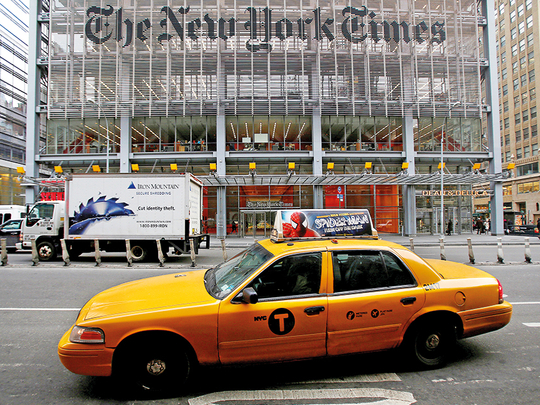
New York
The New York Times offered buyouts to its newsroom employees Wednesday, aiming to reduce layers of editing and requiring more of the editors who remain.
In a memo to the newsroom, Dean Baquet, the executive editor, and Joseph Kahn, the managing editor, said the current system of copy editors and “backfielders” who assign and shape articles would be replaced with a single group of editors who would be responsible for all aspects of an article. Another editor would be “looking over their shoulders before publication.”
“Our goal is to significantly shift the balance of editors to reporters at The Times, giving us more on-the-ground journalists developing original work than ever before,” they said in the memo.
In a separate memo, Arthur Sulzberger Jr., the publisher, said the company would be eliminating the position of public editor, which was established to receive reader complaints and question Times journalists on how they make decisions. Liz Spayd, the current public editor, will leave The Times on Friday.
The buyouts are meant primarily for editors, but reporters and others in the newsroom will also be able to apply for them, the memo said. Baquet and Kahn said that the savings generated by the reduction in editing layers would be used to hire as many as 100 more journalists.
The Times would turn to layoffs if not enough people volunteered for buyouts, Baquet and Kahn said in the memo.
The offer comes as The Times continues its shift from a legacy print operation to a more digitally focused newsroom. Reducing the layers of editing was one of the primary recommendations in an internal study issued in January, the 2020 Report, that was meant to serve as a blueprint for the next phase of that transformation.
In May, the New York Times Co. reported strong digital growth, including a 19 per cent gain in digital advertising revenue.
But those gains were not substantial enough to offset a continuing, industry-wide decline in print advertising, historically the main revenue source for newspaper companies. Print advertising at The Times fell 18 per cent in the most recent quarter, causing an overall decline in advertising revenue of 7 per cent.
The company has increasingly relied on subscription revenue, which spiked amid Americans’ close attention to the presidential election last year and the start of President Donald Trump’s term. The Times registered a net gain of 308,000 digital-only subscriptions in the most recent quarter, the largest number for any quarter in its history. The surge fed an 11 per cent increase in circulation revenue.
It was the second straight quarter of record-breaking subscriber growth, with 276,000 new digital-only subscriptions — more than the total for 2013 and 2014 combined — being added in the last three months of 2016. The Times now has more than 2.2 million digital-only subscriptions.
The public editor position was created in 2003 to rebuild trust among readers after the scandal involving Jayson Blair, a Times reporter who was found to have fabricated sources and plagiarised repeatedly. Spayd, who declined to comment when reached late Wednesday, was the sixth person to hold the position.
Just a few national news organisations, including NPR and ESPN, still have a public editor or a similar position. The Washington Post eliminated its ombudsman in 2013.
Sulzberger, in a newsroom memo, said the public editor’s role had become outdated.
“Our followers on social media and our readers across the internet have come together to collectively serve as a modern watchdog, more vigilant and forceful than one person could ever be,” he wrote. “Our responsibility is to empower all of those watchdogs, and to listen to them, rather than to channel their voice through a single office.”
On Tuesday, The Times announced the creation of the Reader Centre, an initiative that appeared to overlap somewhat with the public editor’s role. The centre will be responsible for responding directly to readers, explaining coverage decisions and inviting readers to contribute their voices.
Grant Glickson, president of the News Guild of New York, the union that represents Times employees, said in a statement that the buyout announcement was “devastating for our members and grave news for the state of journalism.”
“These Guild members don’t simply correct comma splices. They protect the integrity of the brand,” he said. “They are the watchdogs that ensure that the truth is told.”
— New York Times News Service











